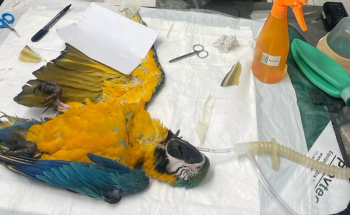
Leading Off: Bartonellosis: Clinical and diagnostic challenges
Since 1990, more than 22 Bartonella species have been described, of which at least half have been implicated or confirmed as animal or human pathogens.
Prior to 1990, only two pathogenic Bartonella species, Bartonella bacilliformis and Bartonella quintana, were known to infect people, whereas bartonellosis was not yet known as a disease in pet or domestic animals. Since 1990, more than 22 Bartonella species have been described, of which at least half have been implicated or confirmed as animal or human pathogens.
Edward B. Breitschwerdt
When a genus of bacteria is discovered or, in the case of Bartonella, rediscovered, numerous clinical, microbiological, and pathological concepts related to disease causation and microbial pathogenesis are sequentially redefined. Subsequently, the medical relevance of the genus undergoes continued maturation as knowledge of the organism, the host immune response, diagnostic test sensitivity and specificity, treatment efficacy, and epidemiology expand. Since the early 1990s, this paradigm of discovery, rediscovery, and ongoing biological and medical redefinition has clearly been applicable to the genus Bartonella. This rapidly expanding body of clinically relevant information has been summarized in three recent reviews.1-3
A UNIQUE PATHOGEN
On an evolutionary basis, these highly fastidious, gram-negative bacteria have become adapted to one or more mammalian reservoir hosts (e.g. cattle, deer, elk, sheep, cats, squirrels, groundhogs, kangaroos, dogs, rats, rabbits), within which Bartonella species usually cause a long-lasting endotheliotropic infection, accompanied by a relapsing intraerythrocytic bacteremia. Also, an increasing number of arthropods, including biting flies, fleas, keds, lice, sand flies, and ticks, are confirmed or suspected vectors for Bartonella species transmission among various animal populations.
In the context of intravascular pathogens, Bartonella species may prove to be unique, as these bacteria can induce intraerythrocytic infection and vascular endothelial infection and, experimentally, can achieve intracellular localization within monocytes, macrophages, dendritic cells, and CD 34+ progenitor cells. In the reservoir-adapted host and perhaps in the accidentally infected patient, Bartonella bacteremia may be chronic, potentially spanning months to years in duration. Although incompletely studied, these bacteria also appear to induce immune suppression through a variety of mechanisms. Collectively, these factors appear to contribute to a diverse spectrum of disease manifestations in people and dogs, including arthritis, endocarditis, epistaxis, granulomatous inflammation, lymphadenopathy, meningoencephalitis, osteomyelitis, panniculitis, and vasoproliferative lesions.1-5
A DIAGNOSTIC CHALLENGE
For the diagnostician, confirming infection with a Bartonella species remains extremely challenging. Bacterial isolation, serology, and PCR amplification of Bartonella species DNA directly from patient samples each have substantial diagnostic limitations. Enrichment culture of blood, cerebrospinal fluid, joint fluid, or various pathological effusions by using Bartonella alpha Proteobacteria Growth Medium (BAPGM—Galaxy Diagnostics) before PCR is performed is often required to document active infection with a Bartonella species.2,4,6,7
Studies from our laboratory have shown that about half of infected dogs will not have detectable antibodies to Bartonella species test antigens.2,6,8 Although unproven, it appears that chronic intravascular infection with a Bartonella species may induce a degree of immunological anergy, resulting in undetectable levels of organism-specific antibodies in some chronically infected patients.
A CONTINUING PURSUIT
Although numerous and important advances have increased our understanding of bartonellosis, there is a substantial need to better characterize various modes of transmission, the duration of infection, deleterious effects on immune function, cellular pathogenesis, optimal treatment regimens, and risk factors for zoonotic Bartonella species infections. Our research to date indicates that veterinary professionals are at risk for occupational exposure to numerous Bartonella species carried by pet and wild animals.2,9,10 In the context of public health, veterinarians should continue to eliminate and control arthropod vectors on animals; avoid bites, scratches, and contact with animal saliva; and exercise caution when obtaining and handling blood and other diagnostic samples.
Editors' note: Dr. Breitschwerdt is the chief scientific officer for Galaxy Diagnostics, which provides the BAPGM test.
Dr. Breitschwerdt is professor of medicine and infectious diseases at North Carolina State University College of Veterinary Medicine and an adjunct professor of medicine at Duke University Medical Center.
REFERENCES
1. Guptill L. Bartonellosis. Vet Microbiol 2010;140(3-4):347–359.
2. Breitschwerdt EB, Maggi RG, Chomel BB, et al. Bartonellosis: an emerging infectious disease of zoonotic importance to animals and human beings. J Vet Emerg Crit Care 2010;20(1):8-30.
3. Chomel BB, Kasten RW. Bartonellosis, an increasingly recognized zoonosis. J Appl Microbiol 2010 Jan 22. [Epub ahead of print]
4. Diniz PPVP, Wood M, Maggi RG, et al. Co-isolation of Bartonella henselae and Bartonella vinsonii subsp. berkhoffi from blood, joint and subcutaneous seroma fluids from two naturally infected dogs. Vet Microbiol 2009;138:368-372.
5. Breitschwerdt EB, Maggi RG. Comparative medical features of canine and human bartonellosis. Clin Microbiol Infect 2009 Apr 30 [Epub ahead of print].
6. Cherry NA, Diniz PPVP, Maggi RG, et al. Isolation or molecular detection of Bartonella henselae and Bartonella vinsonii subsp. berkhoffi from dogs with idiopathic cavitary effusions. J Vet Intern Med 2009;23(1):186-189.
7. Varanat M, Travis A, Lee W, et al. Recurrent osteomyelitis in a cat due to infection with Bartonella vinsonii subsp. berkhoffi genotype II. J Vet Intern Med 2009;23(6):1273-1277.
8. Duncan AW, Marr HS, Birkenheuer AJ, et al. Bartonella DNA in the blood and lymph nodes of Golden Retrievers with lymphoma and in healthy controls. J Vet Intern Med 2008;22:89-95.
9. Breitschwerdt EB, Maggi RG, Duncan AW, et al. Bartonella species in blood of immunocompetent persons with animal and arthropod contact. Emerg Infect Dis 2007;13(6):938-941.
10. Breitschwerdt EB, Maggi RG, Nicholson WL, et al. Bartonella sp. bacteremia in patients with neurological and neurocognitive dysfunction. J Clin Microbiol 2008;46(9):2856-2861.
Newsletter
From exam room tips to practice management insights, get trusted veterinary news delivered straight to your inbox—subscribe to dvm360.






